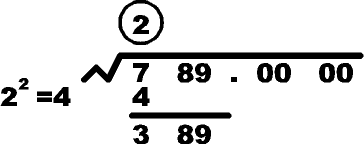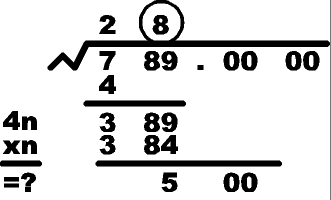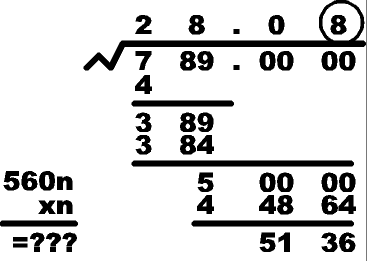Finding the Square Root
(with only Paper and Pencil)
~~~Example: The square root of 789~~~
Add a decimal point and a string of zeroes inside the radical sign for more accuracy. Group the digits in pairs, away from the decimal point (both sides).

Find the largest number that, after squaring, is less than (or equal to) the first group. The first group happens to be the single digit 7. Therefore the first digit in the answer is 2 (because 2^2=4<7, while 3^2=9>7). Write a "2" above the first group.
Square the answer (2^2 =4) and subtract it from 7 (almost like in long division). 7-4=3, so write a "3" underneath the subtraction bar and drop the NEXT group, "89" next to it (still very much like long division):

From now on, the process takes on a confusing twist.
Double and Append: First, you must double your current answer. Your answer right now is 2, and doubling it gives you 4. Now, append the letter "n" to the end of your "4" to create a new number, "4n".
Multiply by n: What is the largest number "n" can be so that [4n x n] will not exceed the "dropped" value of 389? If n=9, then 49x9=441, which is larger than 389. If n=8, then 48x8=384, which is indeed less than 389. Therefore 8 is the second digit in the answer. Draw that number above the second group:

Subtract and Drop: 389-384 = 5. Drop the next group (00) next to the 5 under the bar; almost like you do in long division.
Note: finding "n" takes a bit of trial an error, but "n" is always a single digit.
Double and Append: Your answer right now is 28, and doubling it gives you 56. Append an "n" at the end to create a new number, 56n.
Multiply by n: What is the largest number "n" can be so that [56n x n] does not exceed the dropped value of 500? Well, "5-6-anything" is always larger than 500, so n (the next digit of the final answer) must be 0.

Subtract and Drop: 500-0=500. Drop the next group (00) under the bar next to the 500 to get 50000.
Double and Append: Your answer right now is 280, so doubling it gives you 560. Append an "n" at the end to create a new number, 560n.
Multiply by n: What is the largest number "n" can be so that [560n x n] does not exceed the dropped value of 50000? If n=7, then 5607x7=39249, which seems a little too small. If n=8, then 5608x8=44864, but is that large enough? If you try 9, then 5609x9=50481 (which exceeds the dropped value of 50000), so n=8 must be the next digit in the answer.

Subtract and Drop: 50000-44864=5136. Drop the next group (from the imaginary and infinite series of 00's) to get 513600, but only if you want to continue finding more digits for the answer.
Keep repeating the last three steps for more accuracy. For now it looks like you have the answer accurate to 4 digits, but the truth is you must always ROUND OFF the last digit (just like in long division -again!), which only gives you the 3-digit answer of 28.1 in our example.





